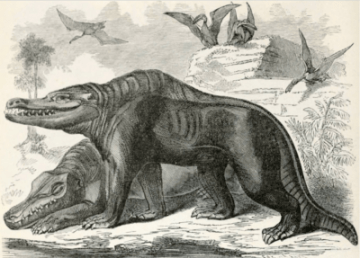Justin E. H. Smith at his website:
 How long have dinosaurs been around? There is one obvious sense in which they ceased to exist 66 million years ago. There is another sense in which they began to exist only around the middle of the 19th century, when Richard Owen identified a “distinct tribe… of Saurian Reptiles” in 1842. Most animals have a long history of social salience before science comes along to tell us exactly where they belong in the order of nature. Not so with dinosaurs: they didn’t have any place in society at all until science informed us of their past existence, and from that point on their salience has been entirely wrapped up in cultural representations. These representations are anchored in something real, in a way that those of unicorns are not, but the fact that we have fossilised skulls and vertebrae to point to in the case of dinosaurs, while we do not have equine skulls with a horn in the middle to point to in the case of unicorns, only makes it more difficult, not less, to understand what we may expect the folk-categorical term “dinosaur” to do.
How long have dinosaurs been around? There is one obvious sense in which they ceased to exist 66 million years ago. There is another sense in which they began to exist only around the middle of the 19th century, when Richard Owen identified a “distinct tribe… of Saurian Reptiles” in 1842. Most animals have a long history of social salience before science comes along to tell us exactly where they belong in the order of nature. Not so with dinosaurs: they didn’t have any place in society at all until science informed us of their past existence, and from that point on their salience has been entirely wrapped up in cultural representations. These representations are anchored in something real, in a way that those of unicorns are not, but the fact that we have fossilised skulls and vertebrae to point to in the case of dinosaurs, while we do not have equine skulls with a horn in the middle to point to in the case of unicorns, only makes it more difficult, not less, to understand what we may expect the folk-categorical term “dinosaur” to do.
At first glance it may seem surprising that there should be a folk-category filled by representations of a class of beings that we (the “folk”) only know to exist at all thanks to what science tells us. But the folk are particularly adept at taking the austere information science delivers, and filling it in with fantasy. This is why black holes figure so prominently in science-fiction scenarios about cosmic consciousness. Yet in the case of palaeontology the people making the discoveries and fleshing out the dry bones with their imaginations, are often much closer to the folk than is generally the case of, say, black-hole cosmologists. And so the original image we have of dinosaurs as “terrible lizards”, an image that never really fit all the available evidence (even if at least some of them had large teeth), is one that was produced by field scientists who were simultaneously making the discoveries and letting these discoveries fuel their imaginations. And from the starter dough of their early imaginings, cultural representations begin to ferment and grow on their own.
More here.
